HISTORY
 What is now the elegant Lawn at the University of Virginia was a busy construction site during the summer of 1819. Two of the five west pavilions were nearing completion, two others were just getting underway, and after a change in plans, work was starting on the east pavilions. Early in July, twenty workmen had arrived from Philadelphia, and Thomas Jefferson announced that "we shall now have about 100 hands at work."
Note: 1 George W. Spooner, one of the master carpenters, reported on the scene as it appeared that August:
What is now the elegant Lawn at the University of Virginia was a busy construction site during the summer of 1819. Two of the five west pavilions were nearing completion, two others were just getting underway, and after a change in plans, work was starting on the east pavilions. Early in July, twenty workmen had arrived from Philadelphia, and Thomas Jefferson announced that "we shall now have about 100 hands at work."
Note: 1 George W. Spooner, one of the master carpenters, reported on the scene as it appeared that August:
Mr. Phillips has commenced laying bricks & has the Basement Story nearly up. Mr. [Ware's] foundation will be ready in a few days, but he is not yet ready for laying not having burnt any of his bricks as yet. Mr. Perry will commence as soon as they have succeeded in blowing a rock which has impedded there progres in diging his foundation.... Mr. Dinsmore is putting up the Modillions on the Cornice of his Pavilion. Mr. Oldam is making his Frames & we shall be ready for his floor of Joists in the course of tomorrow.
Note: 2
Thomas Jefferson, architect of the university and Rector of the Board of Visitors, had lost no time in pushing the construction forward. On January 25, 1819, the Virginia General Assembly had passed the bill establishing the university. The first meeting of the Board of Visitors was not scheduled until the end of March, but Jefferson, anxious to proceed with building, requested a special meeting in February.
Note: 3 Mindful of
"the urgency of the advancing season, & the importance of procuring workmen before they become generally otherwise engaged for the season,"
the Visitors voted unanimously to proceed with contracts
"for building in the approaching season two more pavilions for the Professors one Hotel for dieting the students, and as many additional Dormitories for their lodging, with the necessary appendages"
as funds would allow.
Note: 4 Pavilion I was one of the structures approved at this meeting.
CONSTRUCTION OF THE FIRST BUILDINGS
Two other pavilions were already in place in February, 1819. When the University of Virginia was chartered, it assumed the assets of Central College, including two partially completed faculty structures, Pavilions III and VII. Before the first regular meeting of the Visitors of Central College, which was held in May, 1817, the Visitors had inspected a site for the college and at the meeting approved its purchase, adopted the plan of the grounds that Jefferson had sketched a few years earlier for the Albemarle Academy, and authorized construction of the first building. The minutes of that meeting describe Jefferson's scheme for an "Academical village":
On view of a plan presented to the trustees of Albemarle academy for erecting a distinct pavilion or building for each separate professorship, and for arranging these around a square, each pavilion containing a schoolroom & two apartments for the accommodation of the Professor with other reasonable conveniences the board determines that one of those pavilions shall now be erected; and they request the Proctor, so soon as the funds are at his command to agree with proper workmen for the building of one, of stone or brick below ground, & of brick above, of substantial work, of regular architecture, well executed, and to be compleated if possible during the ensuing summer & winter.
Note: 5
The contract for the carpentry work for this first building, which became known as Pavilion VII, was awarded on June 23, 1817, but the Visitors' hope that it would be completed during the winter was not realized. Jefferson was impatient. He complained to Joseph Cabell, one of his fellow Visitors, that "The dilatoriness of the workmen gives me constant trouble. It has already brought into doubt the completion this year of the building begun [Pavilion VII], which obliges me to be with them every other day .... The walls should be done by our next court, but they will not by a great deal."
Note: 6 The foundation was still incomplete at the end of August, and the cornerstone was not laid until October.
Note: 7 By the fall of 1819, when Pavilion I was under construction, the Visitors had become more attuned to the pace of construction; the minutes noted that "two seasons" were "generally requisite for the accomplishment of good buildings, the one for their walls & covering, the other for inner finishings."
Note: 8
On October 7, 1817, the day following the laying of the cornerstone of Pavilion VII, the Visitors authorized that two more pavilions and their adjoining dormitories "be contracted for and executed the next year."
Note: 9 These buildings would be known as Pavilions III and V, but only Pavilion III was begun in 1818. George Spooner was referring to Pavilion III, this second pavilion, when he wrote in the summer of 1819 that "Mr. Dinsmore is putting up the Modillions on the Cornice of his Pavilion."
 Work on Pavilion V was not begun until 1819. The excavation work proved especially troublesome. In his August report, Spooner said that the contractor for this building, John M. Perry, would begin laying the foundation as soon as rock was blasted away. A fortnight later, Spooner reported continuing problems: "We find considerable dificulty in opening the foundation of Mr Perrys building, being obliged frequently to blow the Rocks which is considerable laboure."
Note: 10 Spooner had also pointed out that Richard Ware, a contractor from Philadelphia, had his foundation nearly ready but was "not yet ready for laying," since he had not yet burned any bricks. This was the foundation for a pavilion on the east side of the Lawn, rather than the hotel which the Visitors had authorized in February.
Work on Pavilion V was not begun until 1819. The excavation work proved especially troublesome. In his August report, Spooner said that the contractor for this building, John M. Perry, would begin laying the foundation as soon as rock was blasted away. A fortnight later, Spooner reported continuing problems: "We find considerable dificulty in opening the foundation of Mr Perrys building, being obliged frequently to blow the Rocks which is considerable laboure."
Note: 10 Spooner had also pointed out that Richard Ware, a contractor from Philadelphia, had his foundation nearly ready but was "not yet ready for laying," since he had not yet burned any bricks. This was the foundation for a pavilion on the east side of the Lawn, rather than the hotel which the Visitors had authorized in February.
Jefferson and the second member of the Visitors' Committee of Superintendence, John H. Cocke , had disagreed after the Visitors' meeting of March, 1819, about plans for the hotels and decided to delay building the hotel until the Visitors met in the fall. However, Jefferson and Cocke nevertheless agreed to build a third structure. They chose to begin the east line of pavilions. Note: 11 In early July, Jefferson wrote to James Breckenridge, another of the Visitors, justifying the start of the east pavilions:
We have adopted another measure however, without [the Visitors'] sanction, because it is in fact a fuller execution of the principles expressed and acted on at their meeting: and we are confident they would have adopted it had it then occurred [to them]. Their idea was to push the buildings to the extent of all the funds we could command. Altho' we had recieved the opinion of the Treasurer and the literary board that we might command at any moment the whole donation for this year, yet it seems not to have occurred to any of us at the time, that we might do the same the next year, and consequently draw it's 15,000. D. on the 1st day of January next. The thought occurring afterwards, we have not hesitated to act on it; & we are proceeding to have 3 pavilions erected on the Eastern range, with their appurtenant dormitores, in addition to the 4 built [Pavilions III and VII], or to be built [Pavilions I and V] on the Western range; so that we may have 7. pavilions, with their dormitories, in progress this year, to be finished the next.
Note: 12
At a meeting in October, 1819, the Visitors retroactively approved the substitution of the pavilion for the hotel, as well as the commencement of two other pavilions, but they also forbade "all further engagements for buildings."
Note: 13
A few days later, Jefferson explained additional circumstances that had accelerated the construction of the east pavilions. Richard Ware, the Philadelphia builder whom Jefferson had planned to engage, had been imprisoned. Two buildings reserved for him were given
"to others who had been competitors from Richmond,"
and they had arrived in Charlottesville. Just then Ware and soon his workmen appeared. "Our embarassment was extreme," Jefferson wrote, "as, to send these people back again was to ruin him. Under this difficulty we resolved, without authority from the board, to engage to him two more pavilions with their adjacent dormitories, making seven with those already on hand, which and more we knew would be ultimately wanting."
Note: 14 It was at this time that Jefferson estimated that there were 100 workmen on the grounds.
Jefferson now faced another predicament as architect of the university, for he had not yet designed the east pavilions. He was concerned about impeding construction and on June 5 instructed the Proctor of the University, Arthur S. Brockenbrough, how to proceed: "those [Eastern] pavilions will vary so little from the dimensions last given, & those of No. I. II. III. of the Western range that if the foundations are dug to that, the trimming them to what shall be the exact size of each will be trifling. The foundations for the dormitories too of both ranges, may give employment in the mean time to the laborers."
Note: 15 Meanwhile, Jefferson worked rapidly on the architectural drawings for the east pavilions and finished them within fifteen days. On June 27, Jefferson told Brockenbrough that the drawings were ready and that he wanted to show them to him before leaving for Poplar Forest for the summer.
Note: 16
Shortly after the Visitors' special meeting in February, 1819, Jefferson arranged for advertisements for workmen to be placed in newspapers in Richmond and Winchester, and in Philadelphia, whose workmen he greatly admired. Jefferson intended the terms outlined in the advertisements to be the same as those of the builders' contracts. He sought the aid of Joseph C. Cabell in placing this notice, which first appeared in the Richmond Enquirer on March 12, 1819:
WORKMEN WANTED -For the buildings to be erected at the University of Virginia near Charlottesville to wit: Brick Makers and Brick Layers, Stone Masons, House Carpenters and Joiners, Plaisterers, Painters and Glaziers, who can produce certificates from known characters of their perfect skill in their line of business and of their good faith and punctuality in the performance of their undertakings.
Brick Makers and Brick Layers -It is proposed to lay about a million of bricks this season in buildings so far distinct that the undertakings may be in one or more portions of about an hundred thousand bricks each, the undertakers finding materials as well as work. The front walls are to be faced with oil stock bricks; the others with sand stocks, the interior mass to be of place bricks -all to be laid with good bond, to be clinkers, and not a single sammel brick to be used in any part of the work, under a penalty of five cents for every such brick, nor more than 2 bats to 9 whole bricks; the inner mortar to be 1/3 lime and 2/3 clean gritty sand, without any mixture of earth; the outer 1/2 lime and 1/2 such sand, and the whole to be grouted with a mortar of the inner quality. In estimating the number of bricks which are to be the usual dimensions, one half of the openings both as to materials and work, are to be deducted. The lime kilns are about 9 miles distant along the public road, and the price of lime has been generally about 16 cents the bushel at the kilns; but it is believed that better lime, and on better terms, may be had from more distant quarries. Good sand is two miles distant. The wood lands commence at about half a mile, and the brick yard with water is about 30 to 40 rods distant: space for the yard, earth for the bricks, sand for mortar, and water for both will be given. Each undertaker is to say what portion of this work he will contract to execute by the 1st day of October next, at what price for the brick, and what for the other materials and work.
Stone Masons are to say for how much they will lay the stone and [mud?] the mortar and grout of the composition before mentioned, leaving the quarrying and hauling for a particular arrangement. The quantity of this work to be done is about 300 perch.
House Carpenters and Joiners. -As the items of house carpentry and joinery and their several prices are too numerous to be specified, some standard of reference for prices must necessarily be proposed, the Philadelphia house carpenter book of prices, printed by M. Carey, in 1812, is adopted for the rule of prices; and every undertaker is to say whether he will undertake at the prices printed in that book, or at what per cent, more or less. Lumber is expected from this reference to be settled at its actual cost; the uncertainty of which might be hazardous for the undertaker; but unseasoned boards must be sufficiently kiln dried by him. Where the item of work and price is not to be found directly in the price book, it is to be deduced from the elements furnished by other articles in the book. -As the buildings are distinct in portions of a little more or less than one thousand bricks, each undertaker is to say of how many of these portions he will contract to finish the wooden work by the 1st day of February next.
Plaisterers, Painters, and Glaziers, may state the several items and prices in their line for which they will work, or they may refer to the Washington price book, published by Evans, and printed there in 1804.... Stating whether they will undertake at the printed prices, or at what per cent, above or below these.
The undertakers in every line are to execute with exactness the general plan and instructions which will be exhibited to them. Making their own working draughts, however, and submitting them to previous examination; the brick and wooden work is to be done as neatly and substantially as the best specimens of what is already done at the same place, and all other work in the very best manner. Whenever work is not finished by the day stipulated, the party failing is to pay as an indemnification, a rent of 10 per cent. on the cost of the building from the day stipulated until his part of the work is finished. Advances of money will be made from time to time to the amount of the materials bro't into place, and of half the workmanship actually done; the balance within six months from the completion of each portion. . . . . .Letters containing proposals are to be addressed to the subscriber as Proctor of the University near Charlottesville, with as little delay as possible, and answers will be promptly returned.
NELSON BARKSDALE.
I hereby certify that Nelson Barksdale is Proctor of the University of Virginia -and that his contracts for the buildings will be valid and obligatory on the funds of the institution.
TH: JEFFERSON, Visitor Note: 17
 Jefferson and Nelson Barksdale, the first Proctor, soon received numerous proposals and recommendations for stonecutters, brick contractors, carpenters, plasterers painters, and glaziers, but all sorts of difficulties arose during the spring and summer. Bids submitted by Virginia contractors were often much higher than the Philadelphia prices that Jefferson had been using as a guideline. The two Italian stonecutters who had been engaged to carve capitals for the pavilions had arrived in Charlottesville. Jefferson had assured James Breckenridge that they were "men of quite superior character," but three days later added a postscript to his letter: "a vast embarrasment has this moment befallen us. Our two Italians examined our quarry yesterday and pronounce it impossible to make of it an Ionic or Corinthian capital, and they can work only in these ornamental parts, & not at all in plain work. I never was so nonplussed. They have cost us a great deal of money, & how to avoid it; becoming a loss, & how to get our work done, is the difficulty."
Note: 18 The proposals for brickwork also proved vexatious. On March 26, Richard Ware submitted a proposal "to undertake three portions mentioned in the advertisement. "
Note: 19 Within two weeks, Jefferson accepted Ware's offer and requested an immediate response but none came. In July, Jefferson complained, "Our works have gone on miserably slow. Not a brick is yet laid."
Note: 20
Jefferson and Nelson Barksdale, the first Proctor, soon received numerous proposals and recommendations for stonecutters, brick contractors, carpenters, plasterers painters, and glaziers, but all sorts of difficulties arose during the spring and summer. Bids submitted by Virginia contractors were often much higher than the Philadelphia prices that Jefferson had been using as a guideline. The two Italian stonecutters who had been engaged to carve capitals for the pavilions had arrived in Charlottesville. Jefferson had assured James Breckenridge that they were "men of quite superior character," but three days later added a postscript to his letter: "a vast embarrasment has this moment befallen us. Our two Italians examined our quarry yesterday and pronounce it impossible to make of it an Ionic or Corinthian capital, and they can work only in these ornamental parts, & not at all in plain work. I never was so nonplussed. They have cost us a great deal of money, & how to avoid it; becoming a loss, & how to get our work done, is the difficulty."
Note: 18 The proposals for brickwork also proved vexatious. On March 26, Richard Ware submitted a proposal "to undertake three portions mentioned in the advertisement. "
Note: 19 Within two weeks, Jefferson accepted Ware's offer and requested an immediate response but none came. In July, Jefferson complained, "Our works have gone on miserably slow. Not a brick is yet laid."
Note: 20
CONSTRUCTION OF PAVILION I
A relatively bright spot in this picture was Pavilion I. Like the other west pavilions, Pavilion I had been allotted to Virginia workmen. The contract for the masonry was given to Curtis Carter and William B. Phillips, of Richmond. On March 24, Carter and Phillips submitted this proposal to Jefferson:
We will contract with you to make & lay from seven to ten hundred Thousand Brick for the Virginia University and compleate it by the first day of November next for the following prices to wit
For all walls faised with oil stock Brick $18 /m
For all walls faised with sand Stock Brick $13 do
all walls such as partitions brest of chimneys and
seller walls below the surface $12 do
The Bricks to be all harde the sand & lime to be the best the nabourhood affords and the worke to be executed in a nice and workman like manner.
Note: 21
 Jefferson had learned about oil stock brick in 1817 in Lynchburgh, which he called "the most growing place in America." He explained to Benjamin Latrobe that "they have there the new method of moulding the stock-brick in oil, and execute it with the most beautiful brick work, I have ever seen. I went there to try to get a workman skilled in it to come and build our first Academical pavilion, for which they are now making the bricks."
Note: 22
Jefferson had learned about oil stock brick in 1817 in Lynchburgh, which he called "the most growing place in America." He explained to Benjamin Latrobe that "they have there the new method of moulding the stock-brick in oil, and execute it with the most beautiful brick work, I have ever seen. I went there to try to get a workman skilled in it to come and build our first Academical pavilion, for which they are now making the bricks."
Note: 22
Early in April, 1819, two weeks after receiving Carter and Phillips's proposal, Jefferson replied that much of the masonry work had already been agreed upon: "Offers to do the work of the University for 11 1/2 Dollars for place-brickwork & 20.D. for oil-stock work have induced us to engage most of the work. We have reserved however about two or 300,000 bricks for you if you chuse to undertake it on those terms. Be so good as to let me know by mail as soon as you can."
Note: 23
The other "offers" to which Jefferson referred included one from Richard Ware of Philadelphia; on the same day that he replied to Carter and Phillips, Jefferson wrote to Ware offering to pay $11.50 per 1,000 place bricks and $20.00 per 1,000 oil stock bricks.
Note: 24 Jefferson's request that Ware confirm the agreement by return mail suggests that the "offers" Jefferson was using to negotiate with Carter and Phillips were not yet binding. Not surprisingly, Jefferson was very upset to learn of Ware's imprisonment. Writing in mid-May to Arthur S. Brockenbrough, the second Proctor of the University, Jefferson said:
I have recieved a letter from Philadelphia which very much affects our arrangements for this year. Mr. Ware on whom we relied to come himself and bring brickmakers & layers to do a whole range of buildings was it seems under embarrassing circumstances, & on it's being known that he was coming here, he was arrested by his creditors & was in jail at the date of the letter. What are we to do? -in the first place keep this a profound secret until we can substitute contracts to supply his place. If you are satisfied that Carter can do as good work as the best already done at the University engage him largely for what is yet to be done .... I shall write immediately to Dr. Cooper to send us on housejoiners from Philadelphia, which he has assured me he could do on the best terms: and I think it necessary for our own credit we should get some workmen from Philadelphia lest we should seem really to have been jockeying our own workmen. Before too that this thing be known you should have written articles signed by all your workmen, for they will endeavor to fly the way when they suspect that the Philadelphia competition is withdrawn.
Note: 25
Brockenbrough followed Jefferson's directions, but Ware soon extricated himself from jail. On May 28, Jefferson wrote to Brockenbrough,
I have great pleasure in informing you that Mr. Ware is arrived .... He says he has secured as many bricklayers brickmakers & house joiners as we can find work for, that they are glad to come at our prices, and will be ready to come off at once on his writing back what work we can give them. I told him that I had written to you; that possibly you had engaged some of the work, tho' probably enough for them would be still disengaged .... I pray you to say what part you have positively engaged and what part we are free to give to those who shall come on from Philadelphia. They will come round by water to Richmond with their tools &c.
Note: 26
 Jefferson considered the building craftsmen in Philadelphia
"the cheapest, and generally the most steady & correct workmen in the US."
Note: 27 He told Brockenbrough he was "really anxious to have these people [from Philadelphia] employed from the knolege I have of their superior activity over those we are used."
Note: 28 He saw the university not only as an architectural showpiece but also as an instrument for encouraging better craftsmanship. He wrote to one of the contractors:
"To have the work done in the best manner, is the first object, and the second to have it done at a fair price for both parties .... I consider it as the interest of the College the town and neighborhood to introduce a reform of the barbarous workmanship hitherto practiced there, and to raise us to a level with the rest of the country."
Note: 29
Jefferson considered the building craftsmen in Philadelphia
"the cheapest, and generally the most steady & correct workmen in the US."
Note: 27 He told Brockenbrough he was "really anxious to have these people [from Philadelphia] employed from the knolege I have of their superior activity over those we are used."
Note: 28 He saw the university not only as an architectural showpiece but also as an instrument for encouraging better craftsmanship. He wrote to one of the contractors:
"To have the work done in the best manner, is the first object, and the second to have it done at a fair price for both parties .... I consider it as the interest of the College the town and neighborhood to introduce a reform of the barbarous workmanship hitherto practiced there, and to raise us to a level with the rest of the country."
Note: 29
Jefferson continued to use the Philadelphia brickmakers and their prices as a negotiating tool with the Virginia contractors, including Carter and Phillips on Pavilion I. In late June, 1819, Jefferson wrote to Brockenbrough about prices over which the Virginia contractors were quibbling:
The terms named to Messrs. Carter & Philips were expressly 11 l/2 2 D. and they can have no more right to refer to what we give Mr Perry this year than to the 15 D. we gave Brown & him the last year .... I would not engage another brick with them beyond the number you have positively and explicitly bound yourself to. In Perry's case a single pavilion [Pavilion V] only is engaged without dormitories or any thing else. You know what you have engaged to Carter & Phillips. The Philadelphia workmen, now probably arrived at Richmond are contented with our price, and their number can be augmented to any amount . . . Reserve every thing therefore not positively engaged for the Philadelphia workmen, that we may establish perfect uniformity for the future.
Note: 30
 Brockenbrough must have succeeded in placating Carter and Phillips, for Jefferson reported on July 8 that although there were delays on other parts of the campus
"they are now however prepared to begin laying the Western pavilion No. I."
Note: 31 Carter and Phillips moved the work along well over the next few weeks; Spooner reported on August 9 that Phillips
"has the Basement Story nearly up."
Carter and Philips were paid $500 on August 12. Spooner reported to Brockenbrough a few days later that Phillips "appears to be uneasy lest his hands should be idle after he has finished the building he is at present engaged on, as there appears to be no arrangement for the Carpenter's work of any other building. I expect if we have dry wether he will finish in three weeks."
Note: 32 Pavilion I was thus the furthest advanced among the pavilions begun in 1819.
Brockenbrough must have succeeded in placating Carter and Phillips, for Jefferson reported on July 8 that although there were delays on other parts of the campus
"they are now however prepared to begin laying the Western pavilion No. I."
Note: 31 Carter and Phillips moved the work along well over the next few weeks; Spooner reported on August 9 that Phillips
"has the Basement Story nearly up."
Carter and Philips were paid $500 on August 12. Spooner reported to Brockenbrough a few days later that Phillips "appears to be uneasy lest his hands should be idle after he has finished the building he is at present engaged on, as there appears to be no arrangement for the Carpenter's work of any other building. I expect if we have dry wether he will finish in three weeks."
Note: 32 Pavilion I was thus the furthest advanced among the pavilions begun in 1819.
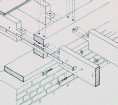 William B. Phillips had been a brick contractor in Richmond since about 1816. He had served an apprenticeship of seven years in the "Bricklaying business" and then worked as a foreman for seven years for N. Turner of Richmond. Turner supplied Phillips with a very favorable letter of recommendation:
"He is trustworthy, an excellent man of good Morality and industrious and attentive to business. I do not know a better workman in that line. He has carried on Brickmaking and laying in this City for two years much to the satisfaction of those who employed him."
Note: 33
William B. Phillips had been a brick contractor in Richmond since about 1816. He had served an apprenticeship of seven years in the "Bricklaying business" and then worked as a foreman for seven years for N. Turner of Richmond. Turner supplied Phillips with a very favorable letter of recommendation:
"He is trustworthy, an excellent man of good Morality and industrious and attentive to business. I do not know a better workman in that line. He has carried on Brickmaking and laying in this City for two years much to the satisfaction of those who employed him."
Note: 33
By 1815, Curtis Carter had become successful enough as a brick contractor to build for himself a substantial, two-story dwelling in Richmond. Between 1816 and 1818 Carter built a house in Richmond for Dr. John Brockenbrough, a physician and prominent citizen; it later became the White House of the Confederacy.
Note: 34 Carter is also credited with the brickwork of several Richmond banks. Note: 35
At first, Jefferson proceeded cautiously with Carter and Phillips, but their work must have proved satisfactory, for they were awarded several other university projects. In a letter written in May about replacing Ware's workmen, Jefferson put the responsibility for the quality of their workmanship upon Arthur Brockenbrough :
"If you are satisfied that Carter can do as good work as best already done at the University engage him largely for what is yet to be done."
Note: 36 Jefferson had spent much of July and August at Poplar Forest and had not had the opportunity to inspect their work as Pavilion I was going up. Later that summer, Jefferson was willing to award Carter and Phillips a small contract for dormitories but asked Brockenbrough to wait until he returned to Monticello before promising any more work:
"By the time you say that Carter & Philips will have finished pavilion No. 1. and dormitories No. 1.2.3.4. I shall be at home; but they may proceed to build the dormitories between Pavilions [III and V] that is to say dormitories No. 5.6.7.8.9.10. These will take 60. or 70,000 bricks, and when I return we will decide according to circumstances whether to give them Pavilion [IX] of the Western range, or one on the Eastern side."
Note: 37 Carter and Phillips succeeded in winning the contract for Pavilion IX and also supplied bricks for the serpentine walls. Carter provided the brick for Pavilion VI and Hotel A, and Phillips for Pavilion X and Hotel C; in addition, they built the appurtenant dormitories.
Note: 38
The master carpenter and joiner for Pavilion I was James Oldham, who had been known to Jefferson for some time. In 1802 Oldham was engaged in installing planking on the terras roof at Monticello and did other work there as well.
Note: 39 He submitted his terms for undertaking the carpentry work at the university on March 27, 1819:
The standard adopted in your advertisement for the rule of Prices, for the carpenters and Joiners worke of the Buildings to be erected at the university of virginia, I tender to you my services to undertake one or two of the buildings at 25 per cent advance on the adopted rule, the worke to be performed agreeable to the terms specified in the advertisement, but the kilndrying of Plank and bordes will be charged for.
Note: 40
A few days later Oldham wrote Jefferson asking to adjust his price:
This morning I was at the university and was informed by Messrs Perry & Dinsmore that they were about handing in proposals different from theare former ones, and if permission be granted to them, I also aske Sur the favor of renewing mine, I have been confin'd & unable to move aboute untill a few days last and from the information I have gethered theare are some little advantages whitch I was not before appris'd of, it is thought that permission will be given to the workemen to erect cabbies for theare convenance on the publick ground whitch, would be a little saveing to them, I am very desireous of getting to worke if on terms only that will cover my daly expenses and am confident the Price I now propose will not exceed it.
Note: 41
Oldham's proposal for the carpentry work was accepted. By August 9, according to Spooner, Oldham was "making his Frames," although without sufficient help. Spooner wrote to the Proctor on August 13, "I wish you would send the hands to Oldham as soon as possible, as I am affraid the bricklayers will be delayd on his building for they are really ready for his Joists & he had not commenced to frame them, he has only one hand besides himself . . . . Mr. Meriwether is furnishing lumber to Oldham at $4.50 delivered at the University."
Note: 42
Like other carpenters of his day, Oldham relied upon architectural treatises and builders' guides for the information needed to make the pavilions "correct in their architecture and execution" as the Visitors had ordered.
Note: 43 Oldham was familiar with these early books. In 1804, he had requested Jefferson's assistance in obtaining a copy of Palladio. Jefferson replied from Washington:
In answere to yours of the 17th desiring me to procure a Palladio for you either here or at Philadelphia, there never was a Palladio here even in private hands till I brought one; and I scarcely expect it is to be had in Philadelphia; but I will try both there and at Baltimore. The late Mr. Ryland Randolph of Turkey island had one, which is probably in the hands of whoever has his books, and as probably out of use. Mr David Randolph could probably give you information respecting it, & whether it can be bought. The chance of getting one in America is slender. In the meantime, as you may be distressed for present use, I send you my portable edition, which I value because it is portable. You will return it at your own convenience. It contains only the 1st book on the orders, which is the essential part. The remaining books contain only plans of great buildings, temples, etc.
Note: 44
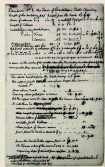 As architect, Jefferson had relied heavily on architectural treatises as he designed the pavilions for the "regular architecture" he desired.
Note: 45 For each of the pavilions Jefferson chose a classical order taken from the plates in the treatises. For the West Lawn, for example, he selected from Andrea Palladio's work the Corinthian order for Pavilion III, the Ionic for Pavilion V, and the Doric for Pavilion VII. He explained the rationale to William Thornton, in 1817:
"Now what we wish is that these pavilions as they will shew themselves above the dormitories, shall be models of taste & good architecture, & of a variety of appearance, no two alike, so as to serve as specimens for the Architectural Lectures."
Note: 46 Later, when it appeared that the university would be assessed a heavy import duty on capitals carved in Italy, Jefferson appealed on the grounds that they were to serve instructional purposes.
As architect, Jefferson had relied heavily on architectural treatises as he designed the pavilions for the "regular architecture" he desired.
Note: 45 For each of the pavilions Jefferson chose a classical order taken from the plates in the treatises. For the West Lawn, for example, he selected from Andrea Palladio's work the Corinthian order for Pavilion III, the Ionic for Pavilion V, and the Doric for Pavilion VII. He explained the rationale to William Thornton, in 1817:
"Now what we wish is that these pavilions as they will shew themselves above the dormitories, shall be models of taste & good architecture, & of a variety of appearance, no two alike, so as to serve as specimens for the Architectural Lectures."
Note: 46 Later, when it appeared that the university would be assessed a heavy import duty on capitals carved in Italy, Jefferson appealed on the grounds that they were to serve instructional purposes.
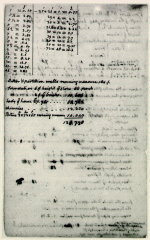 For Pavilion I, Jefferson selected the Doric order of the Roman Baths of Diocletian as illustrated in his 1766 edition of Parallèle de l'architecture antique avec la moderne by Roland Fréart de Chambray and noted the source of the order both on his drawing of Pavilion I and in his specifications of 1819.
Note: 47 Chambray said of this order:
"This Profile was one of the most excellent Pieces of Architecture in the Baths of Diocletian, as far at least as I am able to conjecture from a good number of Draughts which lie yet by me . . . But the Profile is of so noble a Composition, and so regular, that it is nothing inferior to that which went before."
Note: 48
For Pavilion I, Jefferson selected the Doric order of the Roman Baths of Diocletian as illustrated in his 1766 edition of Parallèle de l'architecture antique avec la moderne by Roland Fréart de Chambray and noted the source of the order both on his drawing of Pavilion I and in his specifications of 1819.
Note: 47 Chambray said of this order:
"This Profile was one of the most excellent Pieces of Architecture in the Baths of Diocletian, as far at least as I am able to conjecture from a good number of Draughts which lie yet by me . . . But the Profile is of so noble a Composition, and so regular, that it is nothing inferior to that which went before."
Note: 48
Jefferson owned a copy of this book, but Oldham did not. He wrote to Jefferson at Monticello about his dilemma on June 21, 1819, even before the brick contractors had begun laying the foundation for Pavilion I: "The Dorick of diocletions baths, chambray is not in the Book of Palladio which I have, and I must aske the favor of Mr. Jefferson to lone me the book to lay down my cornice and I will immediately return it safe."
Note: 49
The balance of Oldham's letter about Pavilion I illustrates some of the difficulties that builders faced when applying the forms of ancient architecture to the structures of early 19th century America:
I will be thankefull for instrutions as respects the ceiling of the Portico which I have to do. Those that are now finishing [Pavilions III and VII] I discover are calculated for the ceilings to finish close down on the Top of the cap of the column, this kinde of finish it appears to me will have an awcword affect but if the ceiling is recess and the architrave of the cornice is returnd on the inside of the Portico it will make a meteriale change in the appearance of the columns and will come something neare the rule lade down by Palladio for finishing of Porticoes. Our Proctor is not heare, he gave me no positive instructions as to the manner of finish but referred to those that were going on. It is nesary for the scantling to be made suitable for the finish.
Note: 50
By scantling Oldham probably meant the small, upright wooden members of the frame, which he was constructing that summer. In June, he sent to Jefferson "the Draughts of the window frames for his examination" and also wrote in August, 1822, about flooring planks.
Note: 51 Oldham was paid $1,829.49 in November, 1822, for work at Pavilion I.
Note: 52
Oldham also communicated with Jefferson about his accounts at the university. He told Oldham on January 3, 1822:
"I sincerely regret that any difficulties should arise between "Mr. Brockenbrough and yourself on the subject of your contracts but it is totally foreign to my office to intermeddle with them. I cannot entangle myself in the labyrinth of questions between the Proctor & undertakers, as the contracts are made with him, with him they must be settled as they would be with any other employer in any private case.
He offered some solace by suggesting that payment might be made from the annual state allocation to the university that had become due two days earlier and closed by assuring Oldham "of my best wishes & friendly respects."
Note: 53 In later years Oldham accused the Proctor of fraud and sued the university.
Note: 54
 The stone carving for Pavilion I was done not by the Italian carvers but by a local workman, probably John Gorman, who had worked for Jefferson at Poplar Forest for "about three weeks, dressing and laying some hearthstones andmarble slabs" during the summer of 1819.
Note: 55 Jefferson considered Gorman to be "of the first class of stone cutters for every thing which is not sculpture, being able to prepare an Ionic capitel all but the last finishing .... He is sensible, sober, skilful and industrious and in my opinion would be a valuable acquisition to us."
Note: 56 Jefferson reported that Gorman "understands the business from the quarrying to conducting the work to the outlines for the Sculptor."
Note: 57 He was engaged to carve the Tuscan capitals and bases of the colonnades.
Note: 58 The Doric capital and bases for Pavilion I were probably complete by March, 1821, when Brockenbrough drew up figures to aid Jefferson in estimating the cost of buildings:
The stone carving for Pavilion I was done not by the Italian carvers but by a local workman, probably John Gorman, who had worked for Jefferson at Poplar Forest for "about three weeks, dressing and laying some hearthstones andmarble slabs" during the summer of 1819.
Note: 55 Jefferson considered Gorman to be "of the first class of stone cutters for every thing which is not sculpture, being able to prepare an Ionic capitel all but the last finishing .... He is sensible, sober, skilful and industrious and in my opinion would be a valuable acquisition to us."
Note: 56 Jefferson reported that Gorman "understands the business from the quarrying to conducting the work to the outlines for the Sculptor."
Note: 57 He was engaged to carve the Tuscan capitals and bases of the colonnades.
Note: 58 The Doric capital and bases for Pavilion I were probably complete by March, 1821, when Brockenbrough drew up figures to aid Jefferson in estimating the cost of buildings:
Doric of Pavilion No. 1 West
Base for Quarrying 12.80
Waggonage 1.67
Workmanship 31.50
45.97
Cap " Quarrying 11.20
Waggonage 1.67
Working 26 50
39.37
Note: 59
The Proctors' ledger shows a payment of $255.09 made on July 3, 1822, to Gorman for work at Pavilion 1.
Note: 60
 The Board of Visitors voted unanimously on February 26, 1819, to
"approve of the propositions for covering with tin sheets the pavilions and hotels hereafter to be covered."
Note: 61 Jefferson's experience with tinplates reached back more than two decades. As early as 1795 he had ordered a box of tin plates but did not reveal how they were to be used. In 1802 Jefferson wrote to James Dinsmore , then working as the principal joiner at Monticello, that he was "very much disposed to cover the terras at once with tin. I find that it may be done of the thickest tin for 18. Dollars a square; and it will be proof against fire."
Note: 62 In 1821, as work at the University was underway, Jefferson wrote enthusiastically of the advantages of a tin roof: "It is the lightest, and the most durable cover in the world. We know that it will last 100 years, and how much more we do not know."
Note: 63
The Board of Visitors voted unanimously on February 26, 1819, to
"approve of the propositions for covering with tin sheets the pavilions and hotels hereafter to be covered."
Note: 61 Jefferson's experience with tinplates reached back more than two decades. As early as 1795 he had ordered a box of tin plates but did not reveal how they were to be used. In 1802 Jefferson wrote to James Dinsmore , then working as the principal joiner at Monticello, that he was "very much disposed to cover the terras at once with tin. I find that it may be done of the thickest tin for 18. Dollars a square; and it will be proof against fire."
Note: 62 In 1821, as work at the University was underway, Jefferson wrote enthusiastically of the advantages of a tin roof: "It is the lightest, and the most durable cover in the world. We know that it will last 100 years, and how much more we do not know."
Note: 63
The tin roofing on Pavilion I and on several other pavilions was installed by A.H. Brooks.
Note: 64 The Visitors of Central College had asked Dinsmore to inspect tin roofs that had been installed on houses in Staunton, Virginia. There, Dinsmore reported to Jefferson on November 10, 1818, he met the owners of "the two Principal Houses Covered with Tin" and interviewed "Mr. Brook the workman who put it on."
The owners advised Dinsmore of the necessity of having very smooth and tight planking on which to lay the tin and agreed that his idea of "Painting the tin before laying down" would be advantageous. Dinsmore wrote that with reasonable precautions he felt "justified in saying that a tin Roof may be made as tight as one of any other metal - the last one executed in Staunton (Mr Cowans) has a very handsome appearance and its lightness is certainly a great recomendation. Of its durability they have no Practical Knowledge but have it from good athourity that they have been in use in Montreal & Quebeck for forty or fifty years without Painting & are Still Sound."
Dinsmore quoted Brooks' price for installing the tin and passed on the advice"that Particular attention Should be Paid in the Purchase of the tin there being a Considerable quantity of it of very inferior quality."
Note: 65
Presumably, Dinsmore's report led to the Visitors' decision to use tin. The Proctor's accounts indicate that eight pavilions, including Pavilion I, were covered with tin during 1821.
Note: 66 Brooks, however, fell out of favor with Jefferson, who reportedly
"dismissed him for extravagance in price."
Note: 67 In 1822, Jefferson advised the builders of the Buckingham Court House about him:
Mr. Brooke's price of 6d 30 the square for laying on the tin of a roof, is exorbitant. It may be done, as well as he can do it, for 1. Dollar the square. We went on at the University giving him that price until 3/4 of the houses were covered. We were led to it from a belief that it could not be done without the very expensive and complicated machine which he used to bend the tin, which he told us was a patent machine, costing 40 D. and not to be had in the U.S. At that stage of business I got him to come and cover a small house for me. Seeing how simple the object was, I saw that the same effect could be produced by two boards hinged together. I had this done accordingly, and it did the work as neatly and something quicker than his 40 D. machine, while this could be made for 50 cents . . . Any person will learn to do it in a day as well as in a year.
Note: 68
A few years later, however, Jefferson recommended that Brooks be hired to repair tin roofs at the university that had been laid by a French workman.
Note: 69 According to Francis Eppes, Jefferson's grandson, all of the pavilions at the university had tin-covered roofs.
Note: 70
As with other construction materials, Jefferson had definite ideas about window glass. He told Brockenbrough: "I think too it is not right for us to use English window glass when as good, if not better is made in our own country" and noted that according to the building custom of the day it was "frequent for the employer to find the glass."
Note: 71 In June, 1819, as work was beginning on Pavilion I, Jefferson wrote a Boston manufacturer explaining the university's requirements:
The University we are building within 3 miles of this place will require between 4. and 5000. sq. feet of glass all 12 by 18. I. during the present and next year, and still largely afterwards. Not so much this year as the next, having already received a considerable part this year. . . I must ask the favor of a line as soon as you receive this, informing me whether and when I may count on the arrival at Richmond of the supply now asked for, as it is indispensible that I should make sure of an immediate Supply.
Note: 72
Joseph Antrim, of Lynchburg, submitted a bid for plastering in December, 1817, and carried out plastering work in Pavilion I and other university buildings.
Note: 73 On September 11, 1824, Antrim was paid $432.51 for his work on Pavilion I; in February, 1825, he was paid an additional $164.05.
Note: 74 Jefferson wrote in a letter of recommendation:
"Joseph Antrim has been employed, as plaisterer, to do the whole plaistering of all the buildings of the University of Virginia which he has executed with fidelity and a skill of the first order. He is moreover of perfectly correct habits and conduct, sober, industrious, faithful, and worthy of any degree of trust which may be reposed in him."
Note: 75
 William J. Coffee , a New York sculptor, supplied ornamental work for the university buildings, including Pavilion I. Jefferson had corresponded with Coffee since at least 1818, when Coffee wrote about the use of Roman cement at the university.
Note: 76 Earlier that year, Coffee had executed busts of Jefferson, his daughter, and granddaughter. Born about 1774 in England, Coffee had been a sculptor in terra cotta in Derby and London before moving to New York in 1816.
Note: 77
William J. Coffee , a New York sculptor, supplied ornamental work for the university buildings, including Pavilion I. Jefferson had corresponded with Coffee since at least 1818, when Coffee wrote about the use of Roman cement at the university.
Note: 76 Earlier that year, Coffee had executed busts of Jefferson, his daughter, and granddaughter. Born about 1774 in England, Coffee had been a sculptor in terra cotta in Derby and London before moving to New York in 1816.
Note: 77
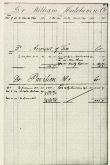 Coffee described the medium of his work for the university as
"Burnt Composition,"
by which he probably meant terra cotta. Brockenbrough called it "baked earth."
Coffee believed that it had many advantages over other materials: "Puty Composition . . . is quite out of use and never Employed, it will not admit of the same relief as my Composition, it will not stand the weather neather can it be got up so Cheape as my Composition, and which is much in use."
He declined to give an estimate for doing work in lead, saying that "it would cost me more than I Could Charge, and I lost Money on the other Lead ornaments that have been sent."
Note: 78 In New York in 1825, terra cotta work was such a specialty that Brockenbrough told Jefferson that Joseph Antrim, the plasterer, had just returned from New York and informed him that "there is so little of that kind of work done there, he could not find any other person in the habit of making composition work."
Note: 79
Coffee described the medium of his work for the university as
"Burnt Composition,"
by which he probably meant terra cotta. Brockenbrough called it "baked earth."
Coffee believed that it had many advantages over other materials: "Puty Composition . . . is quite out of use and never Employed, it will not admit of the same relief as my Composition, it will not stand the weather neather can it be got up so Cheape as my Composition, and which is much in use."
He declined to give an estimate for doing work in lead, saying that "it would cost me more than I Could Charge, and I lost Money on the other Lead ornaments that have been sent."
Note: 78 In New York in 1825, terra cotta work was such a specialty that Brockenbrough told Jefferson that Joseph Antrim, the plasterer, had just returned from New York and informed him that "there is so little of that kind of work done there, he could not find any other person in the habit of making composition work."
Note: 79
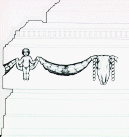 Apparently, Coffee did all of the ornamental work for the university buildings designed by Jefferson. While the price for the decorations for the Rotunda was being negotiated, Coffee wrote
"as I have done all the other ornaments I should not wish that any other work of this kind [be] introduced in the University."
Note: 80 The Proctor's ledger indicates that Coffee was paid $39.00 on September 26, 1822, for work on Pavilion I.
Note: 81 By early 1823, he had created decorations for at least five pavilions.
Note: 82 In anticipation of this work, Jefferson wrote to Brockenbrough in February, 1822:
Apparently, Coffee did all of the ornamental work for the university buildings designed by Jefferson. While the price for the decorations for the Rotunda was being negotiated, Coffee wrote
"as I have done all the other ornaments I should not wish that any other work of this kind [be] introduced in the University."
Note: 80 The Proctor's ledger indicates that Coffee was paid $39.00 on September 26, 1822, for work on Pavilion I.
Note: 81 By early 1823, he had created decorations for at least five pavilions.
Note: 82 In anticipation of this work, Jefferson wrote to Brockenbrough in February, 1822:
I think we should have cornices in all the rooms of the Western hotels. If Architraves & friezes would cost more than the plaister, these may be omitted. I am anxiously waiting for weather & roads to go with Mr. Coffee to the University that he may see for what he can do the ornaments of the friezes in some of the best rooms.
Note: 83
In December, 1822, Coffee shipped to Jefferson "the whole of your Ornaments" for Poplar Forest and mailed detailed instructions for their installation by John Hemings, one of Jefferson's workmen. These pieces included 20 human masks, 24 ox skulls, and 80 feet of "Swag and Boy" frieze, all of "Composition."
Note: 84 In July, 1822, Jefferson had written from Monticello to Coffee about this project and his work for the university:
You are right in what you have thought and done as to the metops of our Doric pavilion. Those of the baths of Diocletion are all human faces, and so are to be those of our Doric pavilion [Pavilion I]. But in my middle room at Poplar Forest, I mean to mix the faces and ox-sculls, a fancy I can indulge in my own case, altho in a public work I feel bound to follow authority strictly.
Note: 85
The order for Poplar Forest was dispatched to Richmond on the schooner Rising States. On the same vessel were
"the Enrichments for the university."
Coffee sent Brockenbrough installation instructions as well.
Note: 86 When the order arrived in Richmond, it was sent by mistake to Monticello, where Jefferson discovered that some of the boxes had been labeled incorrectly and contained part of the order for the university.
Note: 87 He hoped to deliver the order safely to Poplar Forest
"by bedding my boxes in a good quantity of straw in the waggon."
Note: 88
Coffee also agreed to make ornaments for the cornice of the museum room of the library, or Rotunda, in 1825, although his proposal was accepted only after he had reduced his prices by 50 per cent.
Note: 89 Coffee was also busy at this time in Washington and with "some Large Roman Cement Ornaments, at the Collegiate Church, now Building in Canada."
Note: 90
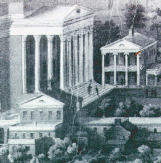 Just a year after the foundation of Pavilion I was begun, Jefferson wrote to John Eppes, husband of his deceased daughter Maria, describing progress at the University:
"By autumn 3 ranges of building will be erected 600. f. long, with colonnades and arcades of the same length in front for communication below, and terrasses of the same extent for communication above: and, by the fall of the next year, a 4th range will be done, which compleats the whole (the Library excepted)."
Note: 91 Two years later, in the fall of 1822, the Visitors reported to the Legislature that the university buildings were nearly complete:
Just a year after the foundation of Pavilion I was begun, Jefferson wrote to John Eppes, husband of his deceased daughter Maria, describing progress at the University:
"By autumn 3 ranges of building will be erected 600. f. long, with colonnades and arcades of the same length in front for communication below, and terrasses of the same extent for communication above: and, by the fall of the next year, a 4th range will be done, which compleats the whole (the Library excepted)."
Note: 91 Two years later, in the fall of 1822, the Visitors reported to the Legislature that the university buildings were nearly complete:
The Visitors . . . have completed all the buildings . . . excepting one, that is to say, ten distinct houses or pavilions containing each a lecturing room, with generally four other apartments for the accommodation of a professor and his family, and with a garden, and the requisite family offices; six hotels for dieting the students, with a single room in each for a refectory, and two rooms, a garden and offices for the tenant, and an hundred and nine dormitories, sufficient each for the accommodation of two students, arranged in four distinct rows between the pavilions and hotels, and united with them by covered ways; which buildings are all in readiness for occupation, except that there is still some plaistering to be done, now in hand, which will be finished early in the present season, the garden grounds and garden walls to be completed, and some columns awating their capitals not yet received from Italy
Note: 92 .
Construction of the library, the "remaining building, necessary to complete the whole establishment" was soon to be started. Note: 93 In October, 1822, the Proctor was directed "to enter into conferences" with skillful and responsible contractors "for the building of the library."
A year later the walls were up. The Visitors delayed the installation of the roof of the library because "it has been thought not advisable to place it on the walls, in their present green state; but rather to give them time to settle and dry until the ensuing season."
Note: 94 The roof was put on in 1824, and the interior nearly done by October, 1826.
Note: 95 Pavilion I and the other buildings were reported to be "in perfect readiness for putting the institution into operation" in October, 1823.
Note: 96 The cost of constructing Pavilion I was $9,992.05. Among the expenses was $45.00 paid in June, 1822, for three stoves.
Note: 97
The first occupant of Pavilion I was John P. Emmet, Professor of Natural History and one of the eight original members of the faculty. He shared the building with numerous animals, including snakes, a white owl, and a bear, and later with his wife, Mary Byrd Tucker, and their children. In the 1830s, the Emmets built a house at Morea, near the university, and moved into it in about 1834. Before Edward H. Courtnay , Professor of Mathematics, took over Pavilion I in 1842, it was occupied by the university chaplains.
Note: 98 Subsequent occupants included Alfred T. Bledsoe (1854-1861), Basil L. Gildersleeve (1861-1876), John R. Page (1876-1887), Albert H. Tuttle (1888-1913), Board of Visitors and Charles B. Maphis, alternating (1914-1919), William H. Faulkner (1919-1945), Carl C. Speidel (1946-1964), and Kenneth R. Crispell (19651987).
ALTERATIONS AND ADDITIONS TO PAVILION I
Soon after the university opened, the tin roofs started leaking. One official wrote in 1827 that "There is hardly a room or a house in the University that does not leak."
Note: 99 In 1830, the Visitors ordered that "proper measures speedily [be] taken for stopping the leaks in the various roofs of the buildings of the University" and that the
"Executive Committee cause to be renewed, annually, one tenth part of the exterior covering of the dormitories on the lawn, and the two pavilions with flat roofs, taking care that the framing shall be of Locust, and the planking of heart pine, heart poplar or Locust. "
Note: 100
These precautions did not, however, correct the problems with the roof of Pavilion I. In the spring of 1832, it was leaking badly. Emmet wrote that
"Every member of my family, with the exception of the infant, is at present seriously indisposed by violent cold and fever taken immediately after the late rain. The room occupied by Mrs. Emmet dripped incessantly. I slept in the chamber with the children and felt the drops falling steadily on my pillow. I positively state to you my conviction that the complete prostration of my family is dependent on the leaking condition of the roofs."
Note: 101 The next summer, the Visitors directed that repairs "in and about Professor Emmet's Pavilion," including "leaks in the roof" be undertaken as soon as practicable.
Note: 102 At the same meeting, they also granted Emmet permission to reside at Morea. Three years later, it was reported that Pavilion I was "exposed to dilapidation and decay in [its] present unoccupied state."
Note: 103
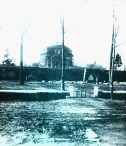 According to John H. B. Latrobe, son of the architect Benjamin H. Latrobe, whom Jefferson had consulted on the design of the campus, the university was at this time in a general state of disrepair. "The whole has a shabby genteel look," he wrote in 1832, "and is already showing marks left by time on its frail materials. The columns are of stucco, some of the capitals and bases of wood, other imported at immense expense from Italy to be joined to brick and plaster. The mortar is peeling off in many places, showing the red bricks underneath. The wood is yawning, with wide, long splits."
Note: 104
According to John H. B. Latrobe, son of the architect Benjamin H. Latrobe, whom Jefferson had consulted on the design of the campus, the university was at this time in a general state of disrepair. "The whole has a shabby genteel look," he wrote in 1832, "and is already showing marks left by time on its frail materials. The columns are of stucco, some of the capitals and bases of wood, other imported at immense expense from Italy to be joined to brick and plaster. The mortar is peeling off in many places, showing the red bricks underneath. The wood is yawning, with wide, long splits."
Note: 104
In addition to repairs, the Board of Visitors also authorized improvements and additions to Pavilion I. In 1828, they approved an expenditure not to exceed $150.00 "to provide accommodation for Servants in the tenement occupied by Doct. Emmet."
Note: 105 Four years later, they approved
"an addition to the basement story for the accommodation of Domestics similar to those already annexed to the Pavilions of Professors Tucker, Bonnycastle, and Harrison, & a stair case from the 2d to the Garret story of Professor Emmet's Pavilion similar to the one already executed in Professor Dunglison's Pavilion."
Note: 106 In 1842, the Visitors assigned Pavilion I to the Professor of Mathematics, Edward H. Courtnay, and directed
"that it be put in order for his reception."
Note: 107 Courtnay and a colleague applied to the Visitors in September, 1850, "for some additional buildings in the rear of their respective Pavilions for the accommodation of their families."
Note: 108 Their request was granted. In the early 1850s Robert Mills was appointed architect for the Annex to the Rotunda, and he may have been involved with the alterations to these pavilions.
On a windy winter night while Dr. Emmet was in residence, soot in a chimney of Pavilion I caught fire; flames lept across the roof but it did not ignite. Another fire that broke out in 1886 was a more serious threat to the building; according to one source, "but for the town engines' promptness in responding to an urgent call, that building probably would have burned down."
Note: 109 The Great Fire of 1895, which destroyed much of the Rotunda, threatened Pavilions I and II as well. They were doused with water:
"As a preventive, blankets, previously thoroughly wetted, were spread over the surface of their north walls and over their fronts; and these were kept continuously saturated by a bucket brigade which passed the water from the ground to the roofs. This water had been obtained from the spigots and hydrants of the nearest pavilions, and was brought by all sorts of people, in all kinds of vessels, from a pitcher to a basin."
Note: 110 In the early years of this century, central heating was installed.
Note: 111
Pavilion I has been an important architectural feature of the Lawn since 1820, when Jefferson wrote prophetically, "our University is now so far advanced as to be worth seeing. It exhibits already the appearance of a beautiful Academical village, of the finest models of building and of classical architecture, in the US. It begins to be much visited by strangers and admired by all, for the beauty, originality and convenience of the plans."
Note: 112
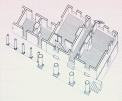

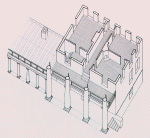
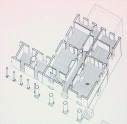
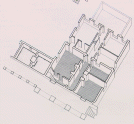
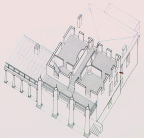
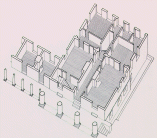
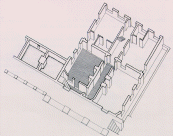
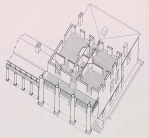
NOTES
Except where noted, all original documents cited are part of the Jefferson Papers of the University of Virginia; they formed the basis of this study. The original spelling, capitalization, and punctuation of these documents have been retained in the quoted excerpts, except that a period has been inserted where one did not appear at the end of a sentence, and the first word of each sentence has been capitalized. The transcription of documents from the Library of Congress and the Massachusetts Historical Society follows the respective practices of the scholars who cited them in their works. Examination of documents in those two collections was beyond the scope of this study.
Table of Contents
Last Modified: Friday, 02-Aug-1996 15:22:20 EDT
 Work on Pavilion V was not begun until 1819. The excavation work proved especially troublesome. In his August report, Spooner said that the contractor for this building, John M. Perry, would begin laying the foundation as soon as rock was blasted away. A fortnight later, Spooner reported continuing problems: "We find considerable dificulty in opening the foundation of Mr Perrys building, being obliged frequently to blow the Rocks which is considerable laboure."
Note: 10 Spooner had also pointed out that Richard Ware, a contractor from Philadelphia, had his foundation nearly ready but was "not yet ready for laying," since he had not yet burned any bricks. This was the foundation for a pavilion on the east side of the Lawn, rather than the hotel which the Visitors had authorized in February.
Work on Pavilion V was not begun until 1819. The excavation work proved especially troublesome. In his August report, Spooner said that the contractor for this building, John M. Perry, would begin laying the foundation as soon as rock was blasted away. A fortnight later, Spooner reported continuing problems: "We find considerable dificulty in opening the foundation of Mr Perrys building, being obliged frequently to blow the Rocks which is considerable laboure."
Note: 10 Spooner had also pointed out that Richard Ware, a contractor from Philadelphia, had his foundation nearly ready but was "not yet ready for laying," since he had not yet burned any bricks. This was the foundation for a pavilion on the east side of the Lawn, rather than the hotel which the Visitors had authorized in February.  What is now the elegant Lawn at the University of Virginia was a busy construction site during the summer of 1819. Two of the five west pavilions were nearing completion, two others were just getting underway, and after a change in plans, work was starting on the east pavilions. Early in July, twenty workmen had arrived from Philadelphia, and Thomas Jefferson announced that "we shall now have about 100 hands at work."
Note: 1 George W. Spooner, one of the master carpenters, reported on the scene as it appeared that August:
What is now the elegant Lawn at the University of Virginia was a busy construction site during the summer of 1819. Two of the five west pavilions were nearing completion, two others were just getting underway, and after a change in plans, work was starting on the east pavilions. Early in July, twenty workmen had arrived from Philadelphia, and Thomas Jefferson announced that "we shall now have about 100 hands at work."
Note: 1 George W. Spooner, one of the master carpenters, reported on the scene as it appeared that August: 





















